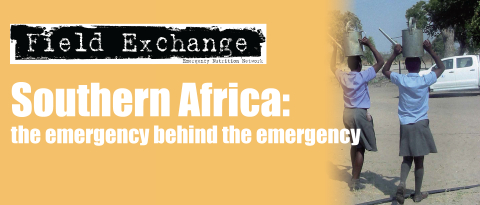Food Security, Nutrition and HIV/AIDS in Relief and Development
Meeting report1
Concern Worldwide UK recently convened a meeting in London on food security, nutrition and HIV/AIDS. The meeting was attended by senior officers from UK-based international humanitarian and development organisations in order to focus on key policy and programming areas, as well as forge inter-sectoral links within the UK. The meeting comprised a number of presentations and plenary discussions.
Stuart Gillespie from International Food Policy Research Institute (IFPRI) opened the presentations by providing an overview of developments since the Durban meeting1 and in particular the work of 'Renewal', which is trying to address the potential relationship between HIV and food security. The initiative has developed a framework that describes the 'vicious cycle' from a livelihoods perspective. This allows one to look at susceptibility to HIV, vulnerability of households to HIV and AIDS and the consequent effects on assets and institutions.
Kate Sadler from Valid International presented on issues related to nutrition and HIV/AIDS focusing on the experiences of employing the Community Therapeutic Care (CTC) approach. She explained how HIV is very closely related to nutritional status. In the developing world, wasting can occur because of lack of food that, in turn, accelerates the onset of chronic AIDS because it decreases the body's resistance to opportunistic infection. Interestingly, the records on CTC show very strongly that CD4 counts are not related to anthropometry. This is important because of the decision about how malnutrition markers cannot be used to gauge CD4 counts. Providing the specially formulated Ready to Use Therapeutic Food (RUTF) to people with HIV and AIDS through community based structures and services within their own homes, can make it easier for them to regain or maintain their nutritional wellbeing. RUTF alone can improve health, so that even those who are bedridden can regain strength and become active enough to work, travel and access treatment. RUTF with anti-retrovirals (ARV) speeds recovery. According to Kate, the increase in Voluntary Counselling and Testing (VCT) is another successful aspect in areas where CTC has been introduced. For example, the dramatic uptake of VCT occurred quite early on in the roll out of CTC in countries like Malawi. This is because VCT was introduced at the same health centre sites as CTC, so people were being exposed to HIV related discussions and opportunities for testing in a much more open way. People were learning early that treatment would be available and this encouraged them to come forward.
Stanley Mwase from Concern Worldwide presented on CTC in Malawi. He explained how, with the introduction of CTC, the use of RUTF inadvertently met with certain cultural perceptions because it resembled an already widely-consumed local peanut butter paste called 'Chiponde'. This presented some problems when RUTF was given to mothers who had malnourished children because the rest of the family would eat the RUTF just like they would Chiponde. So RUTF in Malawi had to be remarketed as a medical treatment rather than as a food. CTC is currently being implemented by the Ministry of Health as a component of primary health care rather than through NGOs as is the current practice with many other programmes. The Malawi government has started formulating strategies to support long term implementation of CTC and has developed a CTC Advisory Service with Concern Worldwide.
Randa Saadeh from WHO then presented on WHO perspectives on nutrition and HIV/AIDS. Randa explained that nutrition impacts on Body Mass Index (BMI) and the lower the BMI, the lower the survival time for People Living with HIV/AIDS (PLHA). Also, those with low BMI can develop high toxicity to ARV treatments. She stressed that although RUTF is effective, it should not be a replacement to providing adequate nutrition through other methods. WHO recommends that micronutrient levels are always adequate. With regard to ARVs, WHO believes that the value of therapy outweighs the risk. However metabolic complications need to be adequately addressed. This is very relevant in some African countries that are using nutrition exclusively, to address HIV.
The final presentation was by Paul Harvey from the Overseas Development Institiute (ODI). Paul suggested that the history of food security/HIV interventions in southern Africa shows how most have involved food aid. While there have been other interventions like home gardens, rabbits and chickens breeding and conservation farming, these have been patchy, while the potential of communities to solve their own problems is often viewed with an unrealistic optimism. Furthermore, there has been too much focus on labour constraints and very little evidence on the impact of interventions like community home gardens. Talking to people about how to eat better or grow crops better is not going to help in the longer term. A patronising attitude to the poor is still quite often seen in nutrition counselling programmes. Paul suggested that we need to look at how to engage with people. For example, there is a growing interest in cash alternatives to food or access to free basic health care as viable alternatives, while livestock production, although a good alternative livelihood strategy, is largely being neglected by most interventions.
For further information and the full report of the meeting contact Karl Deering at Concern Worldwide UK, email: karl.deering@concern.net
1HIV/AIDS and Food and Nutrition Security. From Evidence to Action. April 14-16, 2005, Durban, South Africa. See meeting highlights at: http://www.ifpri.org/events/conferences/2005/20050414HIVAIDS.htm
Imported from FEX website


